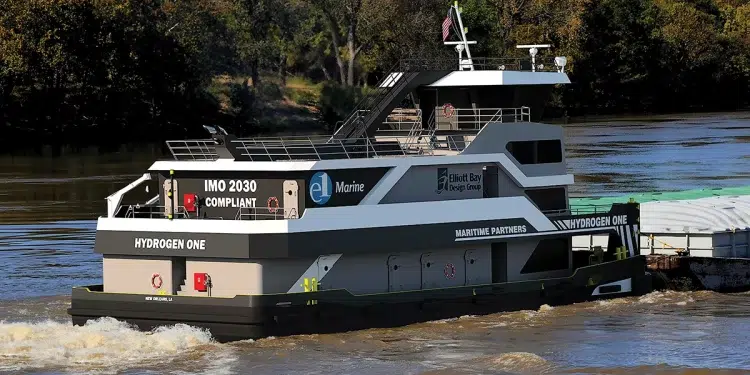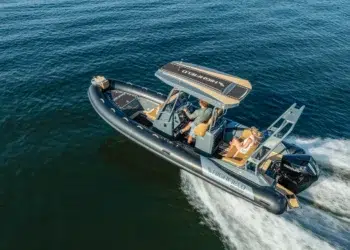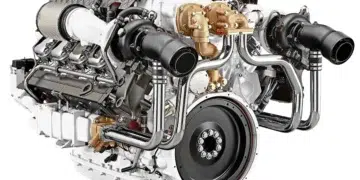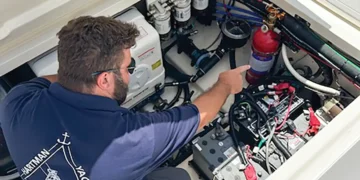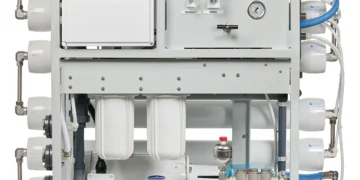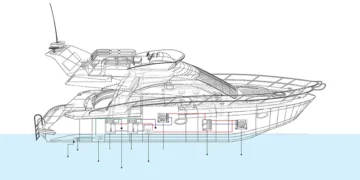The next wave of green marine energy may literally float your boat.
Fuel from water—it’s the stuff of science fiction fantasy that’s tantalized generations of combustion engine owners. While there have been scams aplenty, such as the mysterious “green pill” Louis Enricht proclaimed in 1916 would convert water into gasoline, modern technology is finally turning science fiction into science fact by making hydrogen-powered boats attainable.
Need a few cutting-edge examples?
FEADSHIP 821 (reportedly built for Bill Gates) is a 390-foot superyacht built in the Netherlands’ Royal Van Lent Shipyard that provides carbon-emission-free power from hydrogen. Launched earlier this year, its fuel cell technology can supply an entire week’s worth of silent operation at anchor or emission-free propulsion at 10 knots while leaving harbors or cruising in protected marine zones.
HYDROGEN ONE is a 98-foot tug designed by Elliott Bay Design Group and under construction at Intracoastal Iron Works in Louisiana. Utilizing a unique methanol reformer technology, the tug (scheduled to be launched in mid-2025) will be able to generate all required hydrogen on demand, eliminating the need for cryogenic systems or high-pressure fuel tanks. The pure hydrogen it creates will run through fuel cells and generate electricity for the vessel’s electric motors and L-drive azimuth thrusters.
In February 2024, Yamaha Motor Corporation, U.S.A. unveiled the world’s first hydrogen-powered outboard for recreational boats. Yamaha joined forces with Roush to develop the fuel system to power the new outboard and collaborated with long-time boatbuilder partner Regulator Marine to build a boat suitable for testing the prototype outboard, which is currently undergoing testing.
Also Read
US-Built Highfield Escape 650/750: Deep-V Fiberglass RIBs
Built for America (Cadillac, MI plant + vision) Highfield Boats, America’s leading RIB brand, has introduced the Escape Series, a...
What is it and How is it Made?
Hydrogen is produced through several methods; however, the two most common are steam-methane reforming and electrolysis. Steam-methane reforming uses high-temperature steam (700 degrees Celsius to 1,000 degrees Celsius) to produce hydrogen from a methane source, such as natural gas.
Electrolysis is a process in which a low-voltage current flows through water to form oxygen and hydrogen gas.
Hydrogen is defined as being either “gray” or “green,” a reference to how it’s produced. Gray hydrogen uses fossil fuel sources (primarily natural gas), which in turn produces greenhouse gas, undermining the desired zero impact on the environment. Green hydrogen is the only sustainable source of hydrogen. It’s produced via electrolysis and utilizes electricity provided by renewable resources, such as solar and wind power.
Subscribe Here For More Boating Content
Pros and Cons of Hydrogen-Powered Boats
Hydrogen has a lot going for it. For one, it’s considered a perfectly clean fuel, as the only waste it produces is water.
A hydrogen engine is also a lot more efficient than a gasoline or diesel engine and while you can convert a petroleum engine to run on hydrogen, it’s prohibitively expensive. Another issue with regards to boats (and automobiles as well) is the problem of availability and onboard storage requirements (more on this in a moment).
For now, hydrogen is primarily used in fuel cells, which are in turn used to generate electricity to power electric engines.
A petroleum engine uses only approximately 20 percent of the energy produced, with the remaining 80 percent of energy being lost as heat. That’s the opposite ratio of an electric engine, which uses 80 percent of the energy produced, with only 20 percent lost to energy dispersed.
As for hydrogen cons, one of the primary issues in the past has been storage. Hydrogen storage requires high pressure and low temperature (or a chemical process) and the need for bulky, sensitive high-pressure fuel tanks on board has been problematic—particularly for smaller vessels.
New technology to generate hydrogen on demand (such as that used by the hydrogen-powered tug) eliminates the need for bulky cryogenic systems or high-pressure fuel tanks—something that will make the use of hydrogen more practical for all types of vessels.
Also Read
Another con (from an environmental viewpoint) is that while more efficient and cleaner than fossil fuel engines, gray hydrogen (the vast majority of what’s being produced and used today) still results in pollution. Even using gray fuel, however, the environmental benefits are worth noting.
HYDROGEN ONE, for example, is projected to produce 30 percent less CO2 emissions than a diesel tug of comparable size; however, switching to green methanol (produced entirely from renewable energy sources) would reduce emissions 100 percent, according to its builder.
Probably the biggest challenge for the use of hydrogen as a primary fuel source is availability and cost, which is currently higher than oil and natural gas equivalents. It’s an issue that’s not unique to hydrogen, as other renewable or greener fuel options invariably face similar challenges.
Even boat owners who want to be more environmentally friendly have to face the reality of how much “green” these greener options cost and in most cases it’s not cheap, particularly when compared to more readily available traditional fuels.
As the technology continues to improve, the hope is that increased acceptance and use of hydrogen will result in decreased production cost and increased availability, greatly assisting the goal of carbon neutrality for recreational boating.
-by Frank Lanier


